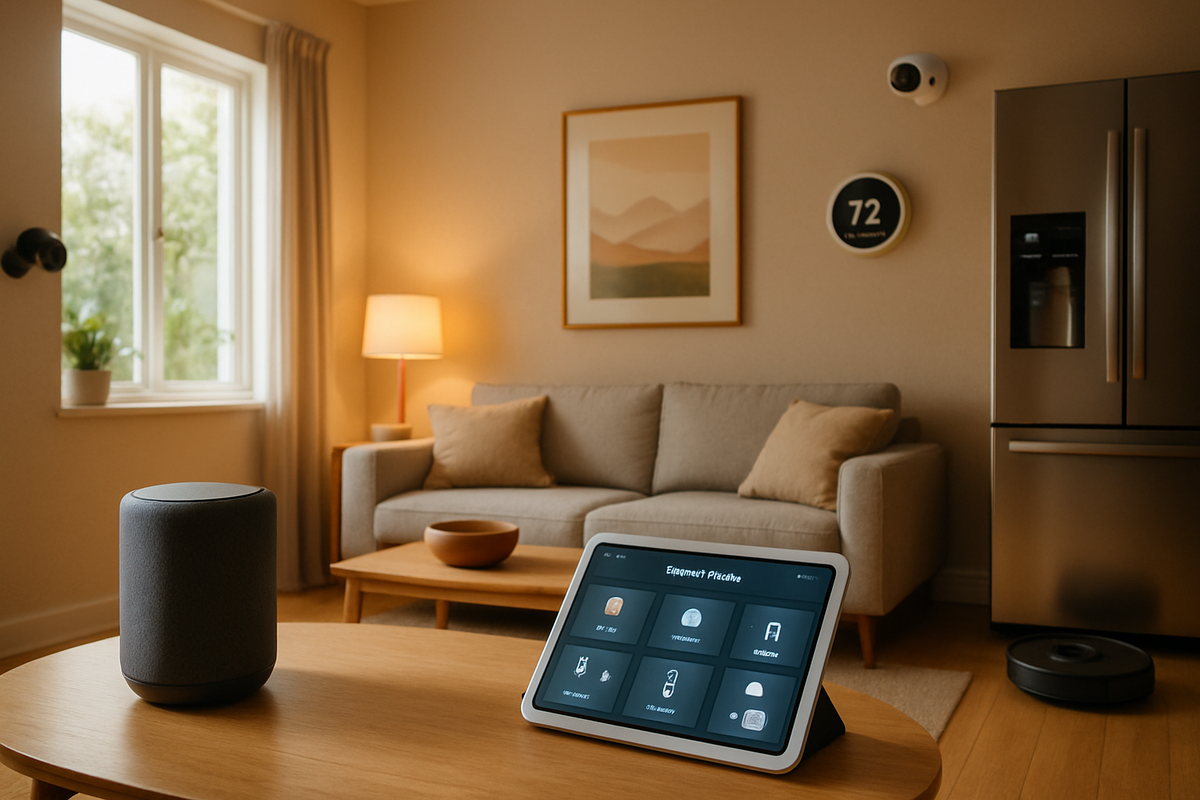The Ultimate 2025 Smart Home ROI Calculator: What Every Homeowner Needs to Know Before Investing in IoT Devices
Discover the real ROI of smart homes in 2025. From savings breakdowns to device payback periods, learn how to turn IoT upgrades into strategic financial wins. Is it worth investing in that AI-powered fridge? Let’s do the math together.

Published: August 19, 2025
Confused by smart home hype, sticker shock, and ROI rumors? Welcome to the only 2025 guide that does the math, busts the myths, and turns IoT upgrades into a strategic win for your wallet and your lifestyle.
“A smart home is no longer a futuristic flex—it's a financial and functional upgrade. But is it worth it for you? Let’s calculate that, together.”
Why Smart Home ROI Is 2025’s Most Searched Question
Let’s face it: Smart homes are everywhere, from TikTok tours to your neighbor’s bragging about their AI-powered coffee maker. But when you Google "is a smart home worth it?", the answers are as clear as a smart mirror after a hot shower. The real question: How much does it cost, and when do you start saving?
With IoT device adoption surging—over 18.8 billion connected devices worldwide and a projected $210B+ smart home market this year—everyone wants to know:
- What’s the true cost (upfront, ongoing, hidden)?
- How fast will I see payback—if ever?
- Which devices deliver the best bang for my buck?
- How do energy savings, insurance discounts, and quality of life upgrades really add up?
Smart Home ROI: The Big Picture (and the Fine Print)
Before you buy that $3,000 fridge that tells you when your kale expires, let’s break down the smart home investment equation:
ROI = (Annual Savings + Lifestyle Value + Resale Bump – Ongoing Costs) ÷ Total Investment
Key cost buckets:
- Device purchase (hubs, lights, thermostats, cameras, locks, fridges, etc.)
- Professional installation (if you’re not a DIY ninja)
- Ongoing subscriptions (for security, cloud storage, AI, or analytics)
- Maintenance & replacements (batteries, bulbs, firmware, warranty plans)
Key value buckets:
- Energy savings (smart thermostats, lighting, plugs, solar integration)
- Insurance discounts (some providers cut rates for security systems, leak sensors, monitored smoke alarms)
- Time saved (automation, remote control, routines)
- Resale value (homes with smart upgrades sell faster and for more—especially in urban/suburban markets)
- Peace of mind (security, wellness, accessibility, and, yes, impressing guests)
2025 Smart Home Costs: Real Device Price Ranges
Here’s what you can expect to pay in the U.S. for leading brands this year (excluding pro install):
| Device | Brand Examples | Avg. Cost (USD) | Typical Subscription |
|---|---|---|---|
| Smart Thermostat | ecobee, Nest | $120–$300 | Optional ($0–$10/mo) |
| Smart Bulbs (per bulb) | Philips Hue, LIFX | $25–$60 | None |
| Smart Lock | August, Yale | $130–$300 | None |
| Security Camera | Ring, Arlo, Nest | $80–$250 | $3–$10/mo |
| Voice Assistant/Hub | Amazon Echo, Google Nest | $100–$250 | Optional |
| Smart Fridge | Samsung Family Hub, LG InstaView | $1,800–$4,000 | None |
| Robotic Vacuum | iRobot Roomba, Eufy | $250–$900 | None |
Want a full cost breakdown by region, subscription, and device type? Subscribers get our exclusive premium tables. Subscribe free to become a Funaix Insider!
How Fast Does a Smart Home Pay for Itself?
Let’s get nerdy: Payback periods vary by device, home size, and energy costs, but here’s what the math says in 2025:
- Smart thermostats: Save 15–23% on heating/cooling. Typical ROI in 1–2 years.
- Smart lighting: Up to 80% energy reduction vs. incandescent. ROI: 2–4 years (faster with motion/automation).
- Security systems: Some insurers offer 5–15% premium discounts. ROI: 3–5 years, plus peace of mind.
- Smart plugs/outlets: Reduce phantom load (standby power) by up to 10%. ROI: 1–3 years.
- Major appliances (fridge, oven): ROI highly variable—buy for features, not just savings.
For a mid-range, 3-bed home going from zero to smart (lighting, thermostat, security, plugs, speakers), expect:
- Upfront investment: $2,500–$4,500
- Annual savings potential: $350–$900 (energy + insurance)
- Payback period: 3–6 years (quicker if you DIY, slower if you go luxury or add lots of bells and whistles)
What About Maintenance and Hidden Costs?
Smart homes aren’t set-and-forget. Here’s what you’ll need to budget for:
- Subscription creep: Cloud storage, AI features, and security monitoring can add $10–$40/month, depending on your setup.
- Maintenance: Battery replacements ($20–$50/yr for locks, sensors), device software updates, and the occasional tech support call.
- Device replacement: Most smart gear lasts 5–7 years. Plan for upgrades or compatibility fixes.
- Network upgrades: Mesh WiFi or routers may be needed for full-home coverage ($150–$800 upfront).
Pro tip: Bundle devices and shop during sales—starter kits and multi-packs can save 20–30% versus piecemeal buying.
Your Personalized Smart Home ROI Calculator: DIY in 3 Steps
- List your goals: Security? Energy savings? Convenience? Entertainment? Accessibility? Prioritize your top 2–3 needs.
- Estimate your spend: Use the tables above to tally device and setup costs. Add 10–20% for extras and surprises.
- Project your savings: Check your current energy/insurance bills. Use conservative savings estimates (see above) for each device category. Don’t forget time saved (what’s an extra hour a week worth to you?).
Subtract ongoing costs, divide by your investment—and voilà: your payback period. If it’s under 7 years, you’re in the smart zone. If not, optimize: start with the highest-ROI devices first.
Regional Price Insights: Does Where You Live Matter?
Absolutely. Entry-level setups in U.S. suburbs start around $800–$1,200, while luxury smart homes in metros or the Middle East can top $100,000. Energy prices, installation fees, and even device availability vary by region. Always compare local quotes and incentives.
Tips to Maximize Your Smart Home ROI in 2025
- Prioritize interoperability: Choose devices that play nice (e.g., Matter, HomeKit, SmartThings).
- DIY where possible: Many devices are plug-and-play. Save big on install fees!
- Automate routines: The more you automate (lights, climate, security), the more you save—in money and minutes.
- Monitor your data: Use built-in analytics to track energy use and optimize further.
- Review subscriptions annually: Cut what you don’t use. Don’t pay for cloud video storage if you never watch it.
The Bottom Line: Is a Smart Home Worth It in 2025?
For most homeowners, yes—if you invest smartly. Start with high-ROI devices like thermostats, lighting, and security. Add luxury features (fridges, AI toilets, VR gaming dens) only if they truly elevate your daily life or resale value. Keep an eye on recurring costs, and remember: the smartest home is one that works for you, not just your Instagram followers.
Want tailored device picks, regional price insights, and our printable 2025 Smart Home ROI Checklist? Subscribe to Funaix for free—only subscribers can comment, ask questions, or grab our exclusive checklists. Don’t miss out—your future smart home (and wallet) will thank you!
Enjoyed this article? Share it with your fellow future-proofers. And remember—only Funaix Insiders get comment access and bonus content. Subscribe today, free (for now).




